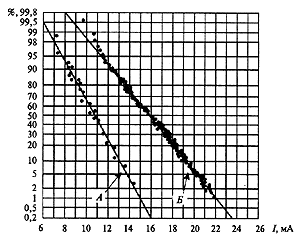2. Electrical safety system
2.2. ELECTRICAL SAFETY CRITERIA
From the very beginning of industrial application of electricity, scientists from all over the world were engaged in studying the effect of electric current on a person and the consequences of this impact. The works of the following authors were widely recognized: HH Egyptien, LP Ferris, DG King, HB Williams, WB Kouwenhoven, CF Dalziel, S. Koeppen, G. Irresberger, H. Hofherr, JT Harley, G. Biegelmeier, E. Reindl, Smola, BJ Simpson, J. Jacobsen, M. Ohashi, T. Kawase, V.E. Manoylova, S.K. Kiseleva, A.I. Sidorova, Yu.V. Sitchikhina, B.A. Knyazevsky, V.I. Shchutsky and many others.
In the 1950s it was unequivocally established that when an electric current is applied to a person, the heart is the most vulnerable organ. Fibrillation (erratic contractions of the muscles) of the heart can occur even at low current values. The versions of asphyxiation, muscle paralysis, brain damage as the causes of death in electroporation were dropped.
It was also found that the result of the action of an electric current on the human body depends not only on the current value, but also on the duration of its course, the current path through the human body, and also, to a lesser extent, on the frequency of the current, the shape of the curve, the ripple coefficient and other factors .
The electrical resistance of the human body depends on skin moisture, the size of the contact surface, the path of current flow through the body, the individual characteristics of the body and other factors. It is known that the resistance of the internal organs of a person does not exceed 500-600 Ohm. The skin resistance in the wet state is extremely small - 10-20 ohms. When determining the electrical safety conditions in the electrical installation, the resistance of the human body is assumed to be 800-1000 Ohms.
Because of the uncertainty of the real value of the resistance of the human body for the estimated assessment of the danger of electroporation in the electrical installation, it is customary to use the current through the human body as a criterion of danger, and not the voltage applied to it.
As an illustration to the above, some results of scientific studies of the effect of electric current on man are given below.

Fig. 2.1. Dependence of the limiting release current on the individual qualities of the subject.
Famous American scientist Charles F. Dalziel in the 1950-60's. Conducted on a large group of volunteers fundamental research on the determination of electrical parameters of the human body and the physiological effect of electric current on a person. The results of his research are considered classical and have not lost their significance to the present time. In Fig. 2.1 shows the experimentally obtained and processed by the methods of mathematical statistics, the dependence of the letting-off current (Let-go) on the individual qualities of a person (A is the experimental data for a group of 28 female subjects, B for a group of 134 men). In Fig. 2.2 graphically represents the region of maximum permissible current and duration of its course through a person with a probability of 99.5% of non-fibrillating hearts (A is the region of unacceptable values).

Fig. 2.2. Graphical interpretation of the limiting time-current parameters, which do not cause cardiac fibrillation.
According to Dalcil, the boundary of the regions of permissible and unacceptable values of current through a person and the duration of its course is determined by the expression:
I = 165 / O T,
Where I is the maximum permissible current through a person, mA; T - duration of current flow through the human body, p.
Specific GOST 12.1.038-82 maximum permissible values of the current through the human body quite accurately correspond to this expression.
Table 2.1.
| T, s | 0.01-0.08 | 0.1 | 0.2 | 0.3 | 0.4 | 0.5 | 0.6 | 0.7 | 0.8 | 0.9 | 1.0 | St. 1.0 |
| I, mA | 650 | 400 | 190 | 160 | 140 | 125 | 105 | 90 | 75 | 65 | 50 | 6th |
Table 2.2.
| T, s | 0.01-0.08 | 0.1 | 0.2 | 0.3 | 0.4 | 0.5 | 0.6 | 0.7 | 0.8 | 0.9 | 1.0 | St. 1.0 |
| I, mA | 220 | 200 | 100 | 70 | 55 | 50 | 40 | 35 | thirty | 27th | 25 | 2 |
In GOST 12.1.038-82 (as amended on 01.07.88) "Electrical safety: Maximum permissible contact and current voltage levels", the maximum permissible values of alternating current at a frequency of 50 Hz are determined through the human body in production (Table 2.1) and household (Table 1). 2.2) electrical installations as a function of the time of exposure.


Comments
When commenting on, remember that the content and tone of your message can hurt the feelings of real people, show respect and tolerance to your interlocutors even if you do not share their opinion, your behavior in the conditions of freedom of expression and anonymity provided by the Internet, changes Not only virtual, but also the real world. All comments are hidden from the index, spam is controlled.